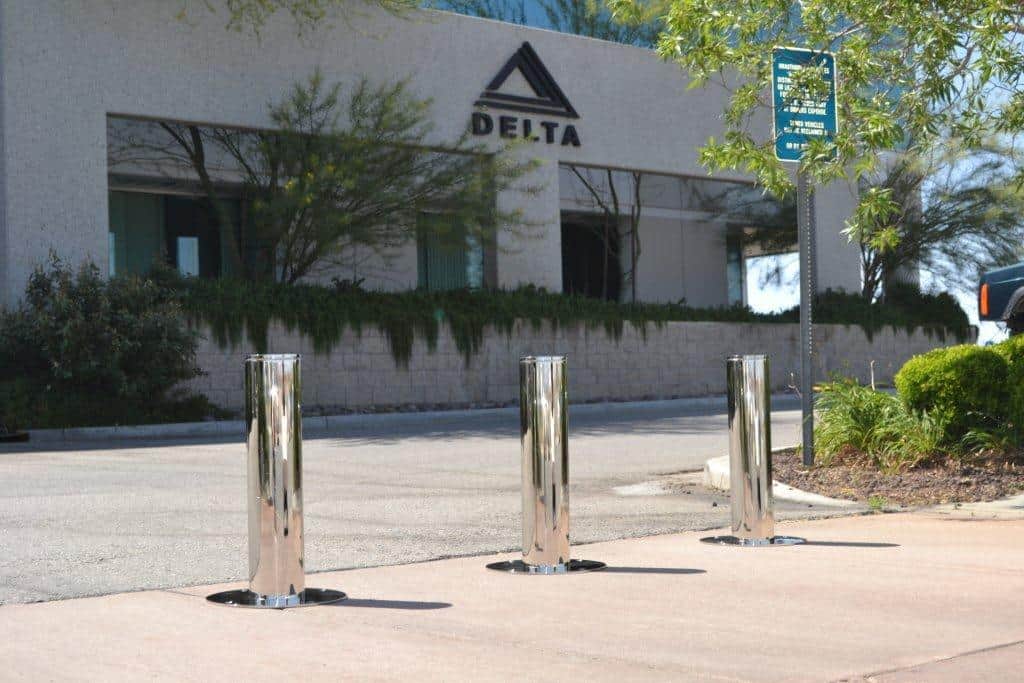What Is the Standard Bollard Height?
A bollard is a short, sturdy post installed into the ground. It delineates parking areas and pedestrian areas. Bollards that offer crash protection, such as those we offer at Delta Scientific, prevent cars from crashing into buildings or onto walkways, causing injuries and property damage in the process. Bollard height is an important consideration when you are purchasing access control systems.
4 Factors That Affect Bollard Height
Traffic bollards typically range between 36 and 42 inches in height. Most Delta Scientific bollards are around 36 inches. We also offer a bollard that is 39.3 inches high, equivalent to one meter.
However, there is no universally accepted height for bollards. Standard bollard height varies according to application. Note that the height of a bollard refers to how much of it extends above grade, i.e., ground level. The part of the post buried beneath the ground does not contribute to the height of the bollard.

1. Location
A traffic bollard of 36 inches, equivalent to three feet or one yard, is adequate for many applications in the United States. However, a bollard of one meter may be preferable in other countries. For example, in Europe, commercial trucks tend to be taller than in the United States. A bollard of only 36 inches may not be adequate to stop these trucks, but a bollard of 39 inches may be more effective.
2. Local Laws
Different jurisdictions may have their own standards for bollard heights. For example, the California Fire Code requires a minimum bollard height of 36 inches for a concrete floor and 48 inches for a concrete pier. However, best practices for schools under construction in New Jersey require a height of 39 to 40 inches above grade.
3. Accessibility
Public buildings and areas such as parks in the United States must comply with the Americans With Disabilities Act. The ADA sets standards for all aspects of construction to ensure that facilities are accessible to everyone, including people with disabilities.
The ADA requires that traffic bollards cannot obstruct parking places designated for those with disabilities, nor impede an accessible route into the property. Bollard height must fall into an acceptable range outlined in the ADA.
4. Visibility
Bollards not only protect pedestrians and buildings, but they also serve as a warning to drivers that vehicles are not allowed in a certain area. To serve as an effective warning, bollards have to be tall enough for drivers to see when seated in their vehicles.
Driving into a bollard at any speed can damage the vehicle. If the vehicle strikes a bollard at a low speed, the damage may be relatively minor, but likely still expensive to repair. Another reason that bollards should be tall enough for drivers to see while sitting in vehicles is to avoid unintentional damage to vehicles by drivers who cannot see the bollards.
Conversely, bollards that are too tall may hide pedestrians from drivers and pose a safety hazard.
Discuss Bollard Height With Delta Scientific
The bollard height you need is tall enough for drivers to see from their vehicles but short enough to avoid hiding pedestrians. It must comply with applicable laws. Our customer support team can answer questions you have about customization options. Contact us to request a quote.
Sources:
https://medium.com/@coveryourbrass/how-tall-are-the-average-parking-bollards-1777bbba2a16
https://www.nj.gov/dca/divisions/codes/alerts/pdfs/2008_11_10_bps_school_construction.pdf
https://codes.iccsafe.org/s/CAFC2022P1/chapter-12-energy-systems/CAFC2022P1-Pt03-Ch12-Sec1207.11.7.3
Share This Story, Choose Your Platform!
